- Publisher's Note
- Editorial
- What's Behind This Orange Facade!
- “First you are drawn in by something akin to beauty and then you feel the despair, the cruelty.”
- Art as an Effective Tool against Socio-Political Injustice
- Outlining the Language of Dissent
- Modern Protest Art
- Painting as Social Protest by Indian artists of 1960-s
- Awakening, Resistance and Inversion: Art for Change
- Dadaism
- Peredvizhniki
- A Protected Secret of Contemporary World Art: Japanese Protest Art of 1950s to Early 1970s
- Protest Art from the MENA Countries
- Writing as Transgression: Two Decades of Graffiti in New York Subways
- Goya: An Act of Faith
- Transgressions and Revelations: Frida Kahlo
- The Art of Resistance: The Works of Jane Alexander
- Larissa Sansour: Born to protest?!
- ‘Banksy’: Stencilised Protests
- Journey to the Heart of Islam
- Seven Indian Painters At the Peabody Essex Museum
- Art Chennai 2012 - A Curtain Raiser
- Art Dubai Launches Sixth Edition
- "Torture is Not Art, Nor is Culture" AnimaNaturalis
- The ŠKODA Prize for Indian Contemporary Art 2011
- A(f)Fair of Art: Hope and Despair
- Cross Cultural Encounters
- Style Redefined-The Mercedes-Benz Museum
- Soviet Posters: From the October Revolution to the Second World War
- Masterworks: Jewels of the Collection at the Rubin Museum of Art
- The Mysterious Antonio Stellatelli and His Collections
- Random Strokes
- A ‘Rare’fied Sense of Being Top-Heavy
- The Red-Tape Noose Around India's Art Market
- What Happened and What's Forthcoming
- Art Events Kolkata, January – February 2012
- Mumbai Art Sighting
- Art Bengaluru
- Delhi Dias
- Musings from Chennai
- Preview, February, 2012 – March, 2012
- In the News-February 2012
- Cover
ART news & views
Outlining the Language of Dissent
Issue No: 26 Month: 3 Year: 2012
by Koeli Mukherjee Ghose
‘Protest art’ is an expansive phrase related to works of art that manifests the disquiet expressed by the artist partaking of social movements, this often bring into being works - in the form of signs, banners, posters wherein the printed materials develop to an essential resource to convey a reason or a message. Time and again, this form of expression of concern, is employed to demonstrate or take up the form of civil - noncompliance. These works tend to be transient and distinguished due to their character of being easily carried from place to place. In many instances they are created as a result of a collective effort and often due to this the art produced are not authored by a single person. A range of symbols for peace, and that of the fist are two instances that highlight the democratic ownership of these signs.
 The first contemporary instrument for propagation, and it’s most original, vibrant and dramatic form was, truly - the poster, produced in Russia before the revolution, these were surpassed by the remarkable propaganda posters of the Soviets. Lenin is recognized for creating the first ever ‘propaganda machine’ from postage stamps, parade on the Mayday and monumental sculptures. The posters became the most popular form used for dissemination of information and strategy. The artists of the time, insisted for changes in policies of the government, for the sustenance of the Soviet people by means of these posters. During the Bolshevik Era (1917 to 1921) the posters were rich in its radical zeal and imposing symbolic representation, the new Economic policy of 1921 to 1927 was a phase of recovery and comparative autonomy, the imagery reflected in the commercial and film posters were avant garde – constructivist in style. Later, during 1928 to 1937 the photomontage posters of the first five year plan echoed the laudable construction of Russia into a fully communist industrialized power. During the great patriotic war of 1939 to 1945 - images reflected the return to symbolism. In 1946 to 1984 the Cold War brought back social realism, in its middle years - the most visible images were that of Vietnam and the space race. In 1984 to the present times as perestroika emerged, the most prevailing images were protest posters, created and posted at great individual risk.
The first contemporary instrument for propagation, and it’s most original, vibrant and dramatic form was, truly - the poster, produced in Russia before the revolution, these were surpassed by the remarkable propaganda posters of the Soviets. Lenin is recognized for creating the first ever ‘propaganda machine’ from postage stamps, parade on the Mayday and monumental sculptures. The posters became the most popular form used for dissemination of information and strategy. The artists of the time, insisted for changes in policies of the government, for the sustenance of the Soviet people by means of these posters. During the Bolshevik Era (1917 to 1921) the posters were rich in its radical zeal and imposing symbolic representation, the new Economic policy of 1921 to 1927 was a phase of recovery and comparative autonomy, the imagery reflected in the commercial and film posters were avant garde – constructivist in style. Later, during 1928 to 1937 the photomontage posters of the first five year plan echoed the laudable construction of Russia into a fully communist industrialized power. During the great patriotic war of 1939 to 1945 - images reflected the return to symbolism. In 1946 to 1984 the Cold War brought back social realism, in its middle years - the most visible images were that of Vietnam and the space race. In 1984 to the present times as perestroika emerged, the most prevailing images were protest posters, created and posted at great individual risk.


Furthermore protest art embraces - graffiti, site-specific installations, performance, and street art, traversing the precincts of art genus, its disciplines and means. Often protest artists evade the art institutions and commercial galleries, taking up the challenge to make a direct contact with a greater number of viewers. Moreover, protest art is not constrained to one region or country, but is rather a method that is used around the world. For example, Publixtheatre Caravan is an international theatre troupe that creates significant performances in everyday spaces around the world.
The Publixtheatre Caravan is a travelling project of the Volxtheater Favoriten, an international theatrical troupe, based in Vienna, known for creating site-specific theatrical intercession in public space as well as on the stage performances since 1994. It is a political - artistic project, integral to the No Border Network and a Platform for a World without Racism. It creates significant performance theatre that zoom in on racism, borders, migration control, biometric data collection, and other forms of social control.
Since May 2001, the Publixtheatre Caravan has been initiating international travelling informational, media, and artistic campaigns, to squat reality, by directly interspersing theater and artistic installations into daily life.
The Volxtheater Favoriten is based out of the Ernst Kirchweger Haus (EKH), the earlier headquarters of the Austrian Communist Party in Vienna, a legally recognized squat that hosts refugees and migrants, community events, and political groups. The Volxtheater does not have directors or a pre-determined cast; the plays are evolved jointly through ruminations over great difference of views.
The Volxtheater perceives itself as an actionist group rousing courage and sense of duty to partake of politics and morality, through its interventions in the public space, through street theatre and guerrilla fun, spontaneous at times and alternative in an intended manner. In the summer of 2000 the initiative to form a caravan to press on the ‘political – actionism’ of the Publix Theatre transpired as a feature of the "cultural caravan through Carinthia and Styria”, to conduct cultural events in villages and small towns in Carinthia and Styria and international resistance days in Klagenfurt, the caravan moved through Austria. The aim was to combine theatrical actions and information campaigns to bring in political and social change. The caravan inscribed monuments with the message "no border no nation - for an open Carinthia, for an open Europe”. The Publixtheatre Caravans of 2001, 2002 and 2003 pervaded internationally, creating dramatic intercessions in public, dressed as biometric researchers, police, border guards and UNO soldiers, motivating viewers and at the same time creating a sense of perplexity amongst them in discerning fiction and reality.
Eleanor Heartney in her writing raises a few questions – “Should artists steer clear of politics on the theory that engagement with social issues stifles the pure nature of art? Or can they rightfully infuse their art with ideology to suggest new models for thought and action?” Thereafter she informs – “Art history provides a rich supply of paradigms for politically engaged art, ranging from the monumental history paintings of Jacques-Louis David to the bitingly satiric Los Caprichos of Francisco Goya. But it is also replete with resolutely apolitical art- the charmingly erotic confections of Jean Honore Fragonard, for example, or the ermine wrapped socialites who beam from the canvases of John singer sergeant.”
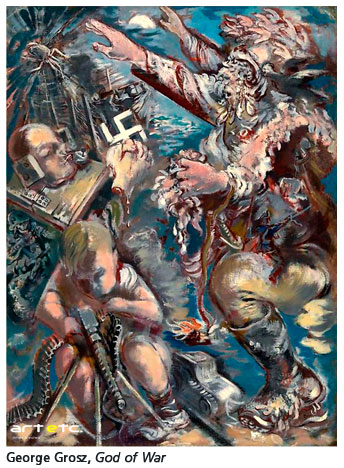
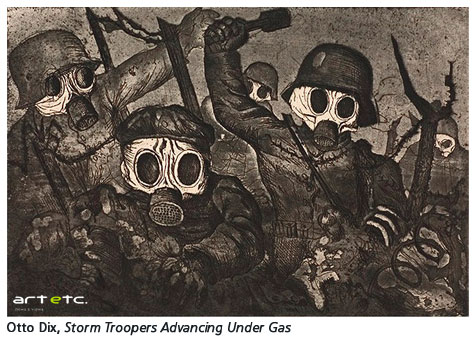 Citing an instance of provoking change through art, Heartney calls to discussion - “the avant – garde and their commitment to charge forth in battle against an oppressive and outmoded ancient regime. Still, it was not always clear whether some avant – garde movements such as Fauvism, advocated persuasive engagement with the world or rather withdrawal from its corruption to a place where ideals could go unsullied. In the early twentieth century, art movements such as Russian Constructivism De Stijl, and the Bauhaus chose engagement, proposing to bring about utopian societies by making intensely rational art. The spectacular failure of those utopian dreams unleashed a darker more active strain of politically oriented art that aimed to expose the corruption and injustices of real societies. One of the great masterpieces of political art is Picasso’s Guernica, 1937, which depicts the Nazi German bombing of Guernica, Spain during the Spanish Civil War. This searing painting has long since transcended its origins, and resonates across time and place as a cry of pain against the pointless suffering inflicted on the helpless victims of war. In Germany between World Wars I and II, artists George Grosz, Otto Dix, and Max Beckmann critiqued the corruption of Weimar Society with Satirical paintings of overfed Bureaucrats, mercenary prostitutes and heartless industrialists. During the same period Mexican muralists Diego Rivera, David Alfaro Siqueiros, and Jose Clemente Orozco promoted revolutionary nationalism in monumental public murals that depicted the sweep of history – from the century old oppression of peasants and workers to the hoped-for socialists utopia of the future. During the 1930’s and 40’s, American artists such as Thomas Hart Benton, Jacob Lawrence, and Ben Shahn explored the shining promise of American democracy and the struggles of workers and social reformers who fought to hold America to its standards.”
Citing an instance of provoking change through art, Heartney calls to discussion - “the avant – garde and their commitment to charge forth in battle against an oppressive and outmoded ancient regime. Still, it was not always clear whether some avant – garde movements such as Fauvism, advocated persuasive engagement with the world or rather withdrawal from its corruption to a place where ideals could go unsullied. In the early twentieth century, art movements such as Russian Constructivism De Stijl, and the Bauhaus chose engagement, proposing to bring about utopian societies by making intensely rational art. The spectacular failure of those utopian dreams unleashed a darker more active strain of politically oriented art that aimed to expose the corruption and injustices of real societies. One of the great masterpieces of political art is Picasso’s Guernica, 1937, which depicts the Nazi German bombing of Guernica, Spain during the Spanish Civil War. This searing painting has long since transcended its origins, and resonates across time and place as a cry of pain against the pointless suffering inflicted on the helpless victims of war. In Germany between World Wars I and II, artists George Grosz, Otto Dix, and Max Beckmann critiqued the corruption of Weimar Society with Satirical paintings of overfed Bureaucrats, mercenary prostitutes and heartless industrialists. During the same period Mexican muralists Diego Rivera, David Alfaro Siqueiros, and Jose Clemente Orozco promoted revolutionary nationalism in monumental public murals that depicted the sweep of history – from the century old oppression of peasants and workers to the hoped-for socialists utopia of the future. During the 1930’s and 40’s, American artists such as Thomas Hart Benton, Jacob Lawrence, and Ben Shahn explored the shining promise of American democracy and the struggles of workers and social reformers who fought to hold America to its standards.”
Heartney elucidates further – “By mid- century, the sorry chronicle of war and oppression in the twentieth century drove some artists away from political engagement. Turning inward, they argued that art should create a space for personal, rather than the universal, freedom. This view reached full expression among the abstract expressionists, who espoused a philosophy of individualism and autonomy in which the corrupting influence of politics played no part. Contrary to such protestations, art historians have demonstrated that detachment did not guarantee disengagement. In the 1970’s Max Kozloff and Eva Cockroft published ground breaking articles revealing that abstract expressionist art was a player in cold war politics. Specifically in the 1950’s, the work of artists such as Jackson Pollock, Mark Rothco, and Barnett Newman, however unwitting they may have been, was exported overseas by the CIA in a series of exhibitions of Contemporary American Art designed to illustrate the superiority of American democracy over Soviet – style communism. In this formulation, Soviet social realism represented a totalitarian regime that forced artists to become agents of the propaganda machine, while abstract expressionism, with its distinctive improvisational marks, symbolized the freedom of action afforded Citizens of America’s democracy.” Protest art has established a special relationship with the public as the responsiveness towards social justice grew widespread universally; an increase in protest art is noticeable. Some of the analytically significant works of the recent times were shown outside the gallery. The ‘Tentative Collective’, a group of artists gathered a cluster of volunteers and team-members to sit on the boundary wall of a park for an hour, in Karachi, as a representation of their longing to triumph over the increase of barrier - in society and the civic landscape. In the invite addressed to the people urging them to attend the happening, they wrote “This social action has been organized in response to the ethnic violence and instability in Karachi, a city of diverse migrant communities, a city that has unfortunately become a city of walls, hedges and barbed wire. Free public space has become gated, walled, priced and policed. Homes have become little fortresses. Could we suggest that these boundaries are arbitrary?”
As indicated by the Tentative Collective, the decision of this “social action” took place on the wall of the Benazir Bhutto Shaheed Park at Boat Basin. The episode fascinated 30 to 40 participants and had fleeting attention of people passing by the location of the busy road.

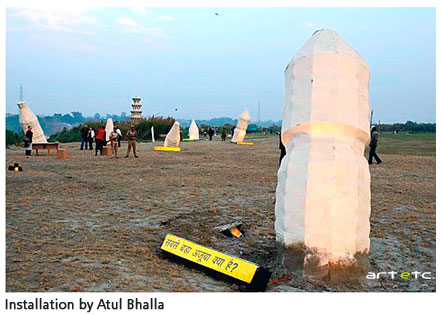
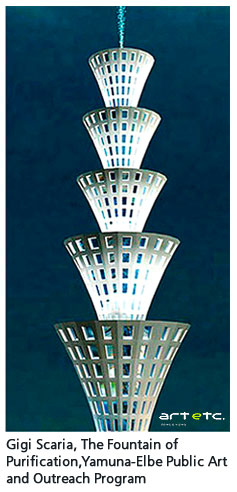
 On another note- as a protest against the “state of emergency” and its regulations imposed in November 2007, late Asim Butt went around the country creating graffiti and murals with social and political messages – the most admired of the progression was the symbol -“eject” that was visible throughout Karachi.
On another note- as a protest against the “state of emergency” and its regulations imposed in November 2007, late Asim Butt went around the country creating graffiti and murals with social and political messages – the most admired of the progression was the symbol -“eject” that was visible throughout Karachi.
 In the installations titled A View from the Banks of the Yamuna River- the gloomy, small area along the bank of the soiled Yamuna, was lit up to showcase the installations of objects associated to the river and its delicate natural balance, a series of bottles lit with fluorescent LED sticks drew light patterns across the water. The happening was announced as 'Yamuna-Elbe Public Art and Outreach Program', an initiative to connect the river Elbe in Hamburg in Germany, to the Yamuna in Delhi. At the heart of the project is a series of public art projects, installations by artists namely Atul Bhalla, Sheba Chhachhi, Asim Waqif and Gigi Scaria. The artists positioned plastic bottles in an extensive tract through the heart of the Yamuna, to expresses the anger of the river goddess for the reason that the water has been inconsiderately polluted. In a creative stance to bring into cognition facts about the river, its sustainability and bionetwork the installation drew more people to the riverfront than its usual passersby, to acknowledge it in its physical form as a heritage within the city.
In the installations titled A View from the Banks of the Yamuna River- the gloomy, small area along the bank of the soiled Yamuna, was lit up to showcase the installations of objects associated to the river and its delicate natural balance, a series of bottles lit with fluorescent LED sticks drew light patterns across the water. The happening was announced as 'Yamuna-Elbe Public Art and Outreach Program', an initiative to connect the river Elbe in Hamburg in Germany, to the Yamuna in Delhi. At the heart of the project is a series of public art projects, installations by artists namely Atul Bhalla, Sheba Chhachhi, Asim Waqif and Gigi Scaria. The artists positioned plastic bottles in an extensive tract through the heart of the Yamuna, to expresses the anger of the river goddess for the reason that the water has been inconsiderately polluted. In a creative stance to bring into cognition facts about the river, its sustainability and bionetwork the installation drew more people to the riverfront than its usual passersby, to acknowledge it in its physical form as a heritage within the city.
The happening was curated by Ravi Agarwal, a Delhi-based environmentalist-artist, and Till Krause, a land artist from Hamburg. Standing at the site of the project, close to Loha Pul, on the northeastern edge of the city - Ravi Agarwal mentioned that the project is trying to create "ecologically sustainable rivers in cities". The highly polluted Yamuna is almost reduced to a drain in the capital…"People have to see the river and decide. No amount of description in newspapers or in the media can compensate for physically experiencing the river." The sight of an illumined wooden quayside touching the shallow pool also had on view - an installation of a suggestive feminine anatomy enfolded in bandages being destroyed by fire, created with effective projections of coloured lights in the central point of the dark river. The replica of an eco-diversity park and a colossal river water purifier, created akin to a high-rise stood out, resembling a contemporary monument.
The influence of activist art is truly manifested once its resourcefulness draws in to focus the inquisitiveness of the people, and the idea is passed on to the hub of their life.
Similar to protest art, activist art practice surfaced partly due to the need to reach a larger viewership and to create new spaces for those artists whose works are unsupported by galleries and museums and this is so due to the nature or content of the work. An aesthetic use of technological developments along with sociopolitical opinions that is often operational in the making of Activist art confronts and problematises the established precincts of cultural representation under authoritarian control.
Activist art integrates the use of public space to deal with socio-political issues and plays a role to convince community and public involvement as a means to steer in social change, by absorbing the viewer in active processes of representation and further the reason to empower individuals and communities not only to play a part but also in, initiating a discourse and hoisting a sense of awareness amongst people. It often requires the artist to ascertain a relationship within the communities where reason to take up such projects occur and the challenge for them is the continuation of forceful of work and the community’s partaking of it.
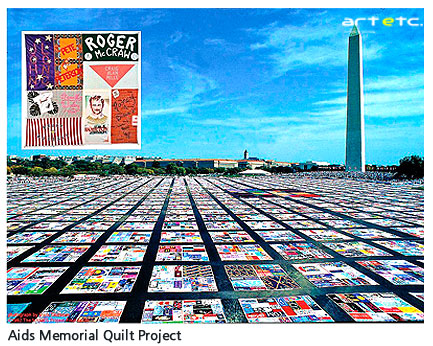 Several social movements are resultant of alternative political and cultural values, particularly expressed through repeated public displays, Throughout 1980s and 90s, agitation in the streets led by the AIDS activists and putting up posters (ACT UP, Gran Fury & Art Positive) effectively brought together million participants for the AIDs Memorial Quilt Project – Bearing testimony to its capacity to portray the thoughts of people coping with personal crisis, the AIDs Memorial Quilt is 1,293,300 square feet and has names of more than 91,000 people who succumbed to AIDS. Moreover the Quilt raised funds of $4,000.000, and the viewing of the entire quilt requires 33 days with one minute spent per panel. In November of 1985, San Francisco based gay rights activist Cleve Jones conceived the idea of the quilt. While planning the 1985 annual candlelight march in memory of gay San Francisco Supervisor Harvey Milk and Mayor George Moscone’s assassinations, Jones came to know that over 1,000 people from San Francisco have died of AIDS. He invited each of the participants in the march, to write the names of friends who had died of Aids, on placards. The placards were then placed on the walls of the San Francisco Federal Building and the wall with the names appeared like a patchwork quilt. Moved by the impact of this expression Jones along with other participants thought of organizing a larger memorial. Thus In June of 1987, the first panel for the AIDS Memorial Quilt came to be in the memory of Jone’s friend - Marvin Feldman. Jones later organized the NAMES Project Foundation.
Several social movements are resultant of alternative political and cultural values, particularly expressed through repeated public displays, Throughout 1980s and 90s, agitation in the streets led by the AIDS activists and putting up posters (ACT UP, Gran Fury & Art Positive) effectively brought together million participants for the AIDs Memorial Quilt Project – Bearing testimony to its capacity to portray the thoughts of people coping with personal crisis, the AIDs Memorial Quilt is 1,293,300 square feet and has names of more than 91,000 people who succumbed to AIDS. Moreover the Quilt raised funds of $4,000.000, and the viewing of the entire quilt requires 33 days with one minute spent per panel. In November of 1985, San Francisco based gay rights activist Cleve Jones conceived the idea of the quilt. While planning the 1985 annual candlelight march in memory of gay San Francisco Supervisor Harvey Milk and Mayor George Moscone’s assassinations, Jones came to know that over 1,000 people from San Francisco have died of AIDS. He invited each of the participants in the march, to write the names of friends who had died of Aids, on placards. The placards were then placed on the walls of the San Francisco Federal Building and the wall with the names appeared like a patchwork quilt. Moved by the impact of this expression Jones along with other participants thought of organizing a larger memorial. Thus In June of 1987, the first panel for the AIDS Memorial Quilt came to be in the memory of Jone’s friend - Marvin Feldman. Jones later organized the NAMES Project Foundation.
People’s response to the Quilt was instantaneous. People from cities most affected by AIDS such as Atlanta, New York, Los Angeles and San Francisco — contributed panels for the workshop in San Francisco. Contributions of sewing machines, equipment and other materials for the making of the quilt came in, People volunteered to create the quilt diligently. The Quilt was first displayed in the National Mall in Washington, on October 11, 1987, at the time of the National March in Washington for Lesbian and Gay Rights. Comprised of 1,920 panels it occupied a very large area, panels created by residents were added in each city. At the end of the tour, the Quilt’s size increased to more than 6,000 panels.
In a variety of approach, the works of art discussed in this treatise resists the challenge of authoritarian power of personal, political or cultural nature that disregards creative engagement and its expressions generating from dissent related to Social -political- economic and cultural views - as unworthy.
A stratagem has to be in place to convey the significance of works of art in dissent be it in the form of protest or activism so that it could be perceived better and not suspected of being manipulative - since the artists are often challenged with the culpability of appropriating the predicaments of marginalized people as the core of their art. Straightforward indignation by artists and groups for the cause of evicted people out of the social circuit is often perceived as intrusion and is accused of ‘misuse for artistic purposes’.
Activist art is meaningful in its rationality to express unconventional views in the cultural, political, economical, and social aspects, bringing in to discourse movements for social change. Moreover activist art holds its historical basis in art and politics but its decisive factors are different to that of political art - in its methodology, strategy, and the goal of the protester.